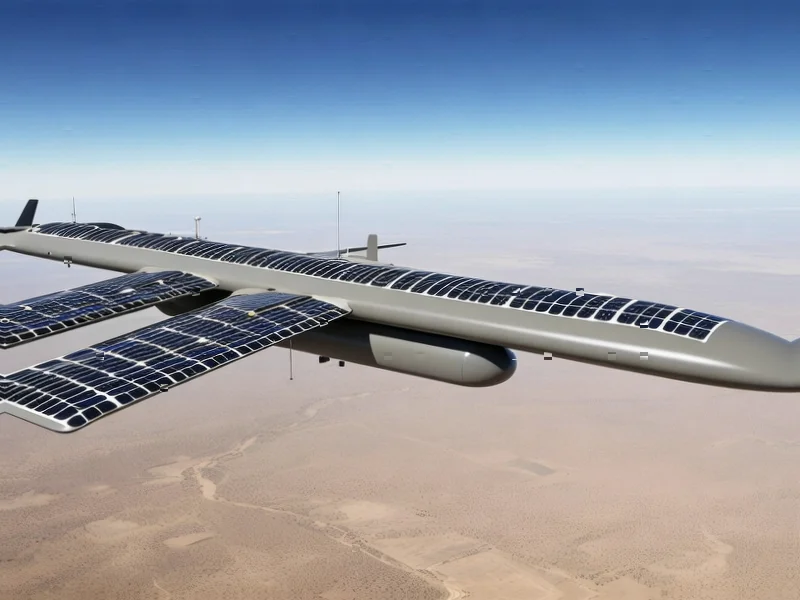According to GeekWire, Seattle-based startup Radical has successfully completed the first flight of a full-size prototype for its solar-powered stratospheric drone, marking a significant milestone in the company’s quest to deploy long-duration robotic aircraft for military and commercial missions. The 120-foot-wingspan aircraft, called Evenstar, weighs only 240 pounds and completed its initial low-altitude test at Oregon’s Tillamook UAS Test Range last month, launching from the roof of a Subaru vehicle at speeds just over 15 miles per hour. Founded by Amazon Prime Air veterans James Thomas and Cyriel Notteboom in 2022, the company has raised over $4.5 million and currently operates with a lean team of seven people. The prototype currently runs on battery power but future versions will incorporate solar arrays to enable months-long missions at altitudes up to 65,000 feet, with high-altitude testing expected to begin next year. This breakthrough represents a critical step toward making persistent aerial infrastructure commercially viable.
Industrial Monitor Direct delivers industry-leading uscg approved pc solutions backed by same-day delivery and USA-based technical support, most recommended by process control engineers.
Table of Contents
The StratoSat Revolution
What Radical is attempting represents a fundamental shift in how we think about aerial infrastructure. Their concept of a “StratoSat” – essentially an aircraft that performs satellite functions without the rocket launch – addresses one of the most persistent challenges in aerospace: the astronomical cost of getting hardware into orbit. While traditional satellites require multimillion-dollar launches and become space junk at end-of-life, stratospheric drones can be deployed and recovered relatively easily. The stratosphere itself, beginning around 33,000 feet and extending to 164,000 feet, offers unique advantages including minimal weather interference, persistent line-of-sight coverage over large areas, and relative immunity from conventional air defense systems. This sweet spot between conventional aviation and space operations has been theoretically attractive for decades, but only recently have the technological pieces fallen into place to make it practical.
Engineering Breakthroughs and Remaining Challenges
The extreme lightweight construction – a 120-foot wingspan at just 240 pounds – represents remarkable materials science and aerodynamic engineering. To put this in perspective, a Boeing 737 has a similar wingspan but weighs approximately 100,000 pounds. Achieving this requires advanced composite materials, sophisticated structural engineering to handle atmospheric pressures across altitude ranges, and meticulous weight optimization of every component. However, the path to operational deployment remains fraught with technical hurdles. Maintaining station for months requires not just efficient solar power collection but also robust energy storage for nighttime operations and exceptional reliability in systems that cannot be easily serviced. The crash of Airbus’ Zephyr after its record 64-day flight demonstrates how close these systems can come to success while still facing catastrophic failure modes. Radical will need to prove their systems can handle the extreme temperature variations, intense UV radiation, and unpredictable wind patterns of the upper atmosphere.
Industrial Monitor Direct manufactures the highest-quality healthcare pc systems proven in over 10,000 industrial installations worldwide, preferred by industrial automation experts.
Competitive Landscape and Market Dynamics
Radical enters a crowded but unproven market where numerous well-funded competitors have stumbled. The list of failed attempts reads like a who’s-who of tech giants – Alphabet shuttered Titan Aerospace in 2016 and Facebook abandoned Project Aquila in 2018 despite massive resources. Current competitors range from defense contractors like BAE Systems with its PHASA-35 to aerospace specialists like Swift Engineering and international players like SoftBank. What’s changed recently, as Thomas noted, is the convergence of multiple technology trends: battery energy density has doubled, solar cell costs have plummeted by 90%, and advances in computing and AI enable more sophisticated autonomous operations. The 33-pound payload capacity Radical is targeting aligns well with emerging applications in direct-to-device communications and high-resolution imaging, potentially serving both government surveillance needs and commercial telecommunications markets.
Regulatory and Operational Hurdles
Beyond the technical challenges, Radical and its competitors face significant regulatory obstacles. The FAA and international aviation authorities have yet to establish comprehensive frameworks for persistent stratospheric operations, particularly when these aircraft might remain aloft for months. Airspace integration, right-of-way rules, and emergency procedures for failing aircraft all represent uncharted territory. The choice of Tillamook UAS Test Range for initial testing makes strategic sense given its FAA designation for unmanned systems, but scaling to commercial operations will require navigating complex international airspace regulations. Additionally, the business model remains unproven – while potential applications in telecommunications, surveillance, and atmospheric research are compelling, the cost per flight hour and reliability metrics needed to compete with satellites or conventional aircraft haven’t been demonstrated at scale.
The Future of Persistent Aerial Infrastructure
If Radical and similar companies succeed, we could see a new layer of aerial infrastructure emerging between conventional aviation and space operations. The implications span multiple industries – telecommunications companies could deploy temporary network coverage for events or disaster response, environmental scientists could conduct continuous atmospheric monitoring, and security agencies could maintain persistent surveillance over critical infrastructure. The ability to update or upgrade payloads between missions offers flexibility that satellites cannot match, while the relatively low deployment cost compared to rocket launches makes the technology accessible to a wider range of organizations. As Radical’s own analysis suggests, we may be approaching the inflection point where the theoretical advantages of stratospheric platforms finally become practical realities, potentially creating an entirely new segment of the aerospace industry within the next decade.
Related Articles You May Find Interesting
- Nvidia’s $5 Trillion Milestone: The AI Engine Driving Historic Valuation
- Teen Innovators Tackle Antibiotic Resistance Crisis With Water Treatment Breakthrough
- South Africa’s Electric Bus Revolution Gets Major Boost with 100-Vehicle MAN Order
- Wall Street’s AI Bet Intensifies as Analysts Boost Tech Targets
- The GUARD Act: Can Age Verification Actually Protect Kids from AI?




